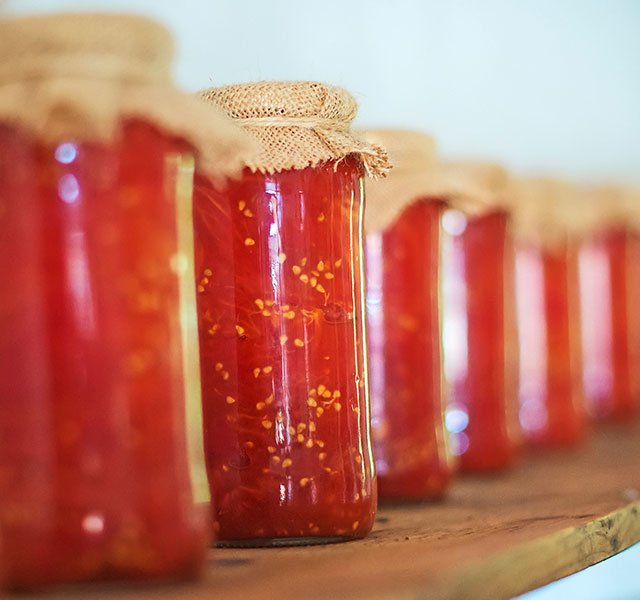Summer is the perfect time to not only recharge your batteries, but also to stock up on those homegrown goodies from your backyard (or from your local farmers market)! The goal of canning and freezing all of the bounty that Mother Nature – and your green thumb – have created is simple: to ensure food safety and preserve quality so that you and your family can enjoy those fruits and veggies all year long.
But how do you do that? There’s more to consider than you might think. Here’s a handy checklist to refer to when saving your summer harvest:
- Know the difference between low acid and high acid foods. This one’s a biggie. There’s a bacteria that can grow in food called Clostridium botulinum. It’s not only a mouthful to say but can be dangerous if it ends up in yours. These bacteria exist as spores and are harmless in the presence of oxygen. That all changes, however, once the oxygen source is removed. In fact, in just a few days without oxygen, these spores multiply and produce Clostridium botulinum, leading to deadly botulism when eaten. To destroy the spores, you need very high temperatures and acid, so knowing the acidity level of your food is key. Before sealing your canning jars, use these tips:
- Low acid foods (foods with a pH of 4.6 to 14 on the alkalinity scale) must reach a temperature of 240 to 250 degrees Fahrenheit and stay there for a period of time (dependent on the type of food and how it is packed in the jars) to be safe. To reach this temperature, you must use a pressure cooker. Low acid foods include carrots, beans, potatoes, peas, corn, most meats, fish and shellfish (though those don’t grow in your garden – we hope).
- High acid foods (pH of 1 to 4.5) can be canned by bringing the jars to a boil (212 degrees Fahrenheit). The cooking time depends on many factors, including the size of the jar, the amount of food being processed, the amount of liquid in the jar and even the altitude you’re cooking in. High acid foods include most fruits, fruit juices and tomatoes with added acidity.
- Don’t take shortcuts. Each step in the storing process is important from a food safety and quality perspective. Don’t skimp on cleaning, heating, peeling, etc.
- Write it down. Make sure all home-canned and frozen foods are labeled with the name of the food and date stored. Then follow the first-in-first-out rule: consuming them in the order you stored them.
- Be freezer savvy. When freezing foods, make sure there is enough room to let air circulate throughout your freezer. Avoid overfilling it to keep it from being overwhelmed. The length of time it takes to freeze food will affect the quality and taste of it. You may also want to dial down the temperature to -10 degrees Fahrenheit for 24 hours before freezing to help the process along. Don’t forget to return your freezer to its normal settings after your food is frozen.
- Be selective. Some foods/meals freeze better than others. Sour cream, custard and anything cream-based don’t freeze well. Fruit, meats, soups, burgers, rolls and muffins do.
So now that you’ve checked everything off your list, what can you make out of those canned and frozen goodies? Here are some Heart Smart recipes that are very freezer-friendly, using ingredients found in your summer harvest:
Zucchini Bread
Yield: Each loaf yields 12 slices. One slice equals one serving, 24 total.
Ingredients:
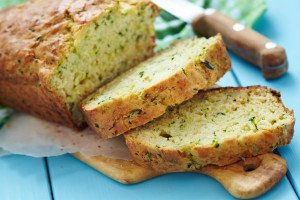
Nonstick cooking spray with flour
1 (7 ounce) container lowfat Greek-style yogurt
1/4 cup canola oil
1 3/4 cup granulated sugar
1 large egg
3 egg whites
1 tablespoon vanilla extract
1 1/2 cups all-purpose flour
1 1/2 cups whole wheat white flour
1 tablespoon ground cinnamon
2 teaspoons baking powder
1 teaspoon baking soda
1/4 teaspoon salt
3 cups shredded zucchini
2 teaspoons orange zest
Glaze:
1/2 cup powdered sugar
2 tablespoons fresh-squeezed orange juice
1 tablespoon melted trans fat-free margarine
Directions:
Preheat oven to 350°F. Spray two 9×5-inch loaf pans with nonstick cooking spray with added flour and set aside. In a large bowl, beat together the yogurt, oil, sugar, egg, egg whites and vanilla. In a separate bowl, combine the all-purpose flour, whole wheat flour, cinnamon, baking powder, baking soda and salt. Add the liquid ingredients to the dry ingredients and gently combine until just moistened, being careful not to over-mix. Add the zucchini and orange zest and stir to combine. Pour the batter into the prepared loaf pans and bake for 45 to 55 minutes or until a wooden pick inserted in the center comes out clean.
To prepare the glaze, combine the powdered sugar, orange juice and melted margarine; stir until smooth. Spread the glaze over the top of the bread while it is still warm. Allow the bread to cool in the pans on a wire rack for 20 minutes. Remove the bread from the pans and cool completely on the wire rack.
Oatmeal Pancakes with Blueberry Sauce
Yield: 8 servings (serving size: 3 pancakes with 2 tablespoons sauce)
Ingredients:
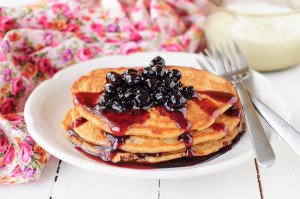
Frozen blueberries, 12 ounces
1/3 cup granulated sugar
1 tablespoon lemon juice
1 tablespoon cornstarch
3 tablespoons water
3/4 cup quick-cooking oats
1/2 cup white whole-wheat flour
1/2 cup all-purpose flour
1/4 cup brown sugar, packed
1 teaspoon baking powder
1/2 teaspoon baking soda
1/4 teaspoon salt
1 cup low-fat buttermilk
1 egg
1 tablespoon canola oil
1 tablespoon vanilla extract
Vegetable oil cooking spray
Directions:
To prepare blueberry sauce, combine blueberries, sugar and lemon juice in a saucepan over medium heat. Allow mixture to gently simmer for 20 to 25 minutes. In a small bowl, combine the cornstarch and water, and stir until dissolved. Reduce heat to medium-low and add cornstarch mixture to blueberry mixture, stirring constantly. Cook one minute on medium-low heat. Remove sauce from heat and allow to cool while preparing the pancakes.
In a large bowl, combine dry oats, whole-wheat flour, all-purpose flour, brown sugar, baking powder, baking soda and salt; mix well. In a medium bowl, whisk together the buttermilk, egg, oil and vanilla. Pour buttermilk mixture over dry ingredients and stir until batter is just combined. Spray a nonstick skillet with cooking spray and set over medium-high heat. When hot, spoon 2 tablespoons of the batter onto pan. Turn pancake when top forms bubbles and edges appear cooked. Briefly cook second side, just long enough to brown. Repeat with remaining batter.
And for some savory options:
Slow Cooker Minestrone Soup
Yield: 11 (1 cup) servings
Ingredients:
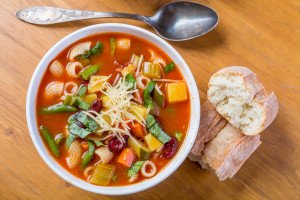
1 can (28 ounces) whole tomatoes
1 can (6 ounces) tomato paste
6 cups fat-free, less-sodium chicken broth
1 1/2 cups cannellini beans, drained and rinsed
1 cup diced onion
1 cup chopped carrots
1 cup chopped celery
1 cup green beans, cut into bite-size pieces
4 cloves garlic, peeled and minced
1/4 teaspoon red pepper flakes (optional)
2 teaspoons dried oregano, divided
2 teaspoons dried basil, divided
1 teaspoon dried thyme, divided
1/2 cup dry elbow macaroni
4 cups baby spinach leaves, lightly packed
2 tablespoons distilled vinegar
11 tablespoons grated Parmesan cheese
Directions:
In a large slow cooker, combine whole tomatoes with juices (crushing each tomato by hand), tomato paste, broth, cannellini beans, onion, carrots, celery, green beans, garlic, red pepper flakes (for heat if desired), 1 teaspoon oregano, 1 teaspoon basil and 1/2 teaspoon thyme. Set cooker on high and cook soup for 4 hours. Prepare macaroni according to package directions, omitting the salt. Add cooked pasta, spinach, remaining oregano, basil and thyme and cook an additional 30 minutes. Add vinegar when cooking time is complete. Each serving consists of 1 cup of soup, garnished with 1 tablespoon of grated Parmesan cheese.
Chili Con Carne
Yield: 9 (1 cup) servings
Ingredients:
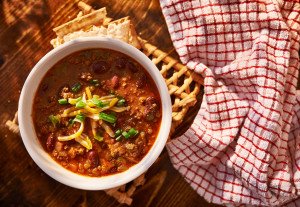
1 pound ground sirloin
1 cup diced onion
1 cup diced green pepper
1 jalapeno pepper, seeded and finely diced
3 cloves garlic, peeled and minced
1/8 teaspoon crushed red pepper flakes (optional)
1 can (28 ounces) whole tomatoes
1 can (14.5 ounces) fat-free, less-sodium beef broth
1 can (6 ounces) tomato paste
1 can (15 ounces) dark red kidney beans, drained and rinsed
1 can (15 ounces) pinto beans, drained and rinsed
3 tablespoons chili powder
2 teaspoons ground cumin
1/4 cup brown sugar
1/2 teaspoon salt
9 tablespoons reduced-fat sour cream
3 to 4 green onions, sliced on the bias
Directions:
In a large pot over medium heat, cook beef until brown; drain fat. Add onion, green pepper, jalapeno, and garlic to cooked beef and cook 5 minutes, or until vegetables soften. Add crushed red pepper flakes, if desired, and cook an additional 1 minute. Add whole tomatoes and juices, crushing tomatoes by hand into bite-size pieces, broth, tomato paste, kidney beans, pinto beans, chili powder, cumin and brown sugar. Cover and continue to cook on low heat for 45 minutes. Add salt and serve, garnishing each serving with 1 tablespoon of reduced-fat sour cream and sliced green onions.
The recipe for healthy and delicious homegrown options? Plant, pick, can, freeze, prepare, serve and enjoy!
Recipes courtesy of Heart Smart®, a registered trademark of the Edith and Benson Ford Heart & Vascular Institute at Henry Ford Hospital.
If you’d like more cooking tips, be sure to check out our schedule of upcoming cooking classes Henry Ford West Bloomfield Hospital.

